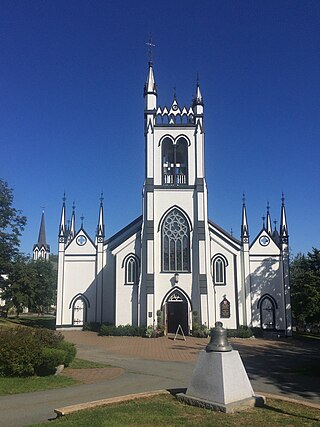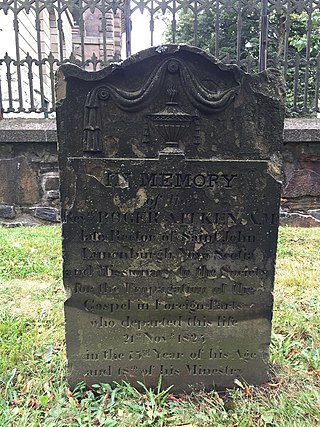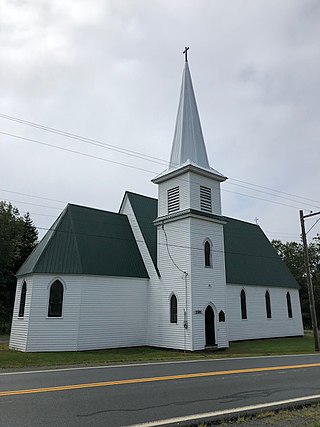
Lunenburg is a port town on the South Shore of Nova Scotia, Canada. Founded in 1753, the town was one of the first British attempts to settle Protestants in Nova Scotia.

St. Paul's Church is an evangelical Anglican church in downtown Halifax, Nova Scotia, within the Diocese of Nova Scotia and Prince Edward Island of the Anglican Church of Canada. It is located at the south end of the Grand Parade, an open square in downtown Halifax with Halifax City Hall at the northern end.

The Old Burying Ground is a historic cemetery in Halifax, Nova Scotia, Canada. It is located at the intersection of Barrington Street and Spring Garden Road in Downtown Halifax.
Garrison Cemetery is a cemetery located on the grounds of Fort Anne in Annapolis Royal, Nova Scotia. It is located next to the old Court House, at the intersection of George St. and Nova Scotia Trunk 1.

John Creighton was one of the founding fathers of Lunenburg, Nova Scotia. He led the settlement through the turbulent times of Father Le Loutre's War, the French and Indian War and the American Revolution. He represented Lunenburg County in the Nova Scotia House of Assembly from 1770 to 1775. After establishing the town, he lived the rest of his life in the village until he died fifty-four years later.

Beamish Murdoch was a lawyer, historian, and political figure in Nova Scotia. He represented Halifax township in the Nova Scotia House of Assembly from 1826 to 1830. He was born in Halifax, Nova Scotia, the son of Andrew Murdoch and Elizabeth Beamish. His family had come to Nova Scotia from the North of Ireland. His grandfather, a Presbyterian minister, Rev. James Murdoch served several parishes in the Province for 23 years. Murdoch was admitted to the Nova Scotia bar in 1822. In 1824 he was elected Vice - President of the Charitable Irish Society in Halifax. He also contributed articles to the Acadian Recorder and the Acadian Magazine or Literary Mirror. Murdoch was defeated by Stephen Wastie Deblois when he ran for reelection in 1830; he was an unsuccessful candidate again in 1836 and 1840. He served as president of the Halifax Temperance Society. In 1841, Murdoch became clerk for the Central Board of Education and, in 1852, was named record for the city of Halifax. Between 1865 and 1867, he published A History of Nova-Scotia, Or Acadie. He died in Lunenburg at the age of 75. He is buried with a gravestone at the Hillcrest Cemetery.
Zion Evangelical Lutheran Church may refer to:

The Raid on Lunenburg occurred during the American Revolution when the US privateer, Captain Noah Stoddard of Fairhaven, Massachusetts, and four other privateer vessels attacked the British settlement at Lunenburg, Nova Scotia on July 1, 1782. The raid was the last major privateer attack on a Nova Scotia community during the war.

The Little Dutch (Deutsch) Church is the second-oldest building in Halifax, Nova Scotia, Canada, after St. Paul's Church. It was built for the Foreign Protestants, and is the oldest site in Canada associated with Lutheranism. It is a National Historic Site of Canada.

Camp Norway was a Norwegian military training facility located in Lunenburg, Nova Scotia, Canada, during the Second World War.

Johann Gottlob Schmeisser was an Evangelical Lutheran minister who was the second minister of Lunenburg, Nova Scotia and served for 24 years. He arrived during the American Revolution, and, after being in the village for only two months, he was involved in the defense of the town during the Raid on Lunenburg, Nova Scotia (1782).

The Zion Evangelical Lutheran Church is a church in Lunenburg, Nova Scotia. The church is the home of the oldest active Lutheran congregation in Canada. German Lutheran settlers arrived in 1753 and held services in the open air and later at St. John's Anglican Church (Lunenburg). The first church on this site was built in 1772 in preparation for the arrival of its first pastor, the Rev. Mr. Friederich Schultz at Lunenburg. He stayed for 8 years.

St. John's Anglican Church was the first church established in Lunenburg, Nova Scotia, Canada (1753). It is the second Church of England built in Nova Scotia, and is the second oldest continuous Protestant church in present-day Canada. Early on 1 November 2001, St. John's church suffered significant damage by fire. It was restored and re-dedicated June 12, 2005.

Jean-Baptiste Moreau was first minister at St. John's Anglican Church (Lunenburg) (1753-1770) and one of the founding fathers of the community. He was one of two missionaries who first arrived in Halifax with Edward Cornwallis (1749) and served at St. Paul's Church (Halifax). His wife had the first child born in Halifax and was named Cornwallis after the Governor. Then in 1753 he was sent to help establish Lunenburg, Nova Scotia. Rev Moreau served the community throughout the French and Indian War. He reported to Society for Propagation of the Gospel (SPG) in London, "…the number massacred by Indians in Lunenburg District during the War was 32." He learned the Mi'kmaw language and is reported to have baptised a number of Mi'kmaq children. He is buried in the crypt of St. John's Anglican Church

St. Andrew's Presbyterian Church is a church in Lunenburg, Nova Scotia. The congregation is the longest history of any Presbyterian congregation in Canada. After meeting at a private house, the congregation worshipped in St. John's Anglican Church (Lunenburg) (1759-1770). The first church was built in 1770 and the first minister was Reverend Bruin Romkes Comingo, who served the community for 50 years until he died at age 95 (1820). The current church was built in the neo-gothic style and dates from 1828.
The Old Parish Burying Ground is the oldest protestant cemetery in Windsor, Nova Scotia and one of the oldest in Canada. The graveyard was located adjacent to the first protestant church in Windsor (1788). The oldest marker is dated 1771, twelve years after the New England Planters began to settle the area.

Roger Aitken was a Scottish Anglican priest known for his service as a missionary at Lunenburg, Nova Scotia (1817-1825) for the Society for the Propagation of the Gospel in Foreign Parts. He was the rector at St. John's Anglican Church and was instrumental in gaining construction of the Rectory and in founding St. Peter's Anglican Church, New Dublin.

St. Peter's Anglican Church is a church in West LaHave, Nova Scotia that was established in 1818 by Roger Aitken, the missionary at Lunenburg for Society for the Propagation of the Gospel in Foreign Parts (1817-1825). The first church was built in 1829 and consecrated in 1834. The church remains active. Aitken gave to the church the oldest known Anglican Chalice and Paten in Canada.

Dr. Jonathan Prescott was a British officer who fought at the Siege of Louisbourg (1745), became the Captain of the militia at Chester, Nova Scotia and later was involved with the Raid on Chester, Nova Scotia (1782). He was the father of Charles Ramage Prescott and uncle of Dr. Samuel Prescott who finished the "midnight ride" begun by Paul Revere.

The Raid on Chester occurred during the American Revolution when the US privateer, Captain Noah Stoddard of Fairhaven, Massachusetts, and four other privateer vessels attacked the British settlement at Chester, Nova Scotia on 30 June 1782. The town was defended by Captain Jonathan Prescott and Captain Jacob Millett.



















